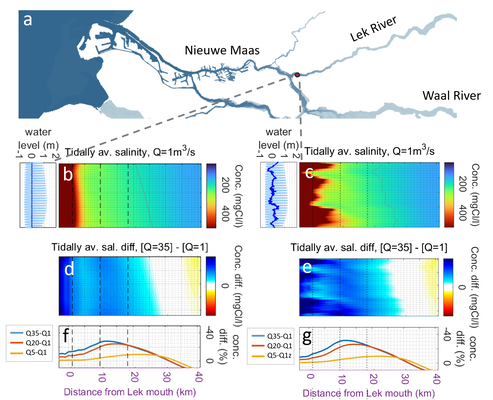Y. Huismans1,2*, L. Leummens1, S.M.T. Rodrigo1, S.C. Laan1, W.M. Kranenburg1,2, R. van der Wijk1, N.P. van Veen3
1 Deltares, the Netherlands; 2 Delft University of Technology, the Netherlands; 3 Rijkswaterstaat, the Netherlands
* Corresponding author: Ymkje.Huismans@Deltares.nl
Introduction
Salinity intrusion occurs naturally in estuarine systems and is strongly governed by the tidal conditions and river discharge (Fischer et al., (1979)). Therefore, most of the freshwater intakes are located far upstream. However, during events of low river discharge or wind setup, salt can intrude far into the system. One of the most effective methods to mitigate salt intrusion is to increase the river discharge (Hendrickx et al., 2023), for example by locally diverting additional water. This is also the main measure applied for keeping intakes along the Lek River – a side branch of the Rhine-Meuse Estuary (figure 1a) – fresh (van den Brink et al., 2019). The additional water, however, comes from the Waal River, where it is needed to guarantee sufficient depth for navigation. As a result, it is important to be as efficient as possible when supplying additional water to the Lek River. To determine the suitable timing and amount for adjusting the discharge through the Lek River, in-depth understanding of the efficacy across different discharge and tidal scenarios, as well as response times, is needed.
Objective and Methods
The objective of this study is to provide the necessary knowledge to arrive at guidelines for optimizing the amount and timing of a freshwater pulse through the Lek River. This includes determining conditions at which the Lek River salinizes, the spatial and temporal reduction in salt intrusion that can be achieved by providing a freshwater pulse, and related response times. For this we applied a detailed 3D Flexible Mesh model for the entire Rhine-Meuse Estuary, which has been validated for water levels, discharge distribution and salinity intrusion (Van der Kaaij et al., 2022). We examined the influences of three primary factors on salt intrusion in the Lek River: 1) the discharge entering the Rhine-Meuse Estuary, 2) the water levels at sea, including a spring-neap tidal cycle and wind setup, and 3) the discharge on the Lek River itself. To isolate the impact of each parameter on salt intrusion, we varied them individually. In addition, we carried out a data-analysis of salinity and discharge measurements of the Lek River from 2022.
Results
From the simulations it follows that only for very low river discharges the salinity front of 200 mg Cl/l passes a critical freshwater intake. Wind setup significantly influences salt intrusion (see Figure 1b,c), with a 50 cm variation leading to displacement of several kilometers in intrusion length. The change in length and response time correlate with the substantial additional water volumes entering and leaving the Lek River due to variations in wind setup.
The efficacy of an additional discharge on the Lek River varies spatially (see Figure 1d,f). While chloride concentrations are most significantly reduced at the river mouth in absolute terms, the relative effect increases in upstream direction, until reaching the river section with near background chloride concentrations. This aligns with expectations, as chloride concentrations near the river mouth are primarily influenced by the main branch (Nieuwe Maas), which has a discharge one order of magnitude higher than the Lek River. With wind setup, effectiveness slightly increases (see Figure1 e,g). Consistent with previous findings (Biemond et al., 2022), the response time of salinity is faster for increasing discharge than for decreasing discharges.
The above findings will be used to formulate a new advice for steering discharge over the Lek River.

Map of the Rhine-Meuse Estuary (a). Chloride concentration on the Lek River for a pure spring-neap tidal cycle (b) and including wind setup (c), both for a Lek discharge of 1 m3/s and a discharge entering the Rhine Meuse Estuary of 450 m3/s. Water levels and surge displayed in the side panel. Reduction in chloride concentration due to extra discharge over the Lek River (5, 20 or 35 m3/s) for a pure spring-neap tidal cycle (d,f) and including wind setup (e,g).
References
Biemond, B., de Swart, H. E., Dijkstra, H. A., & Díez-Minguito, M. (2022). Estuarine salinity response to freshwater pulses. Journal of Geophysical Research: Oceans, 127, e2022JC018669. https://doi.org/10.1029/2022JC018669
Fischer H.B., List E.J., Koh R.C.Y., Imberger J., Brooks N.H. (1979) Mixing in Inland and Coastal Waters Academic Press (1979), 10.1016/C2009-0-22051-4
Hendrickx, G.G., Kranenburg, W.M., Antolínez J.A.A., Huismans, Y., Aarninkhof, S.G.J., Herman, P.M.J. (2023), Sensitivity of salt intrusion to estuary-scale changes: A systematic modelling study towards nature-based mitigation measures, Estuarine, Coastal and Shelf Science, 295, 108564, https://doi.org/10.1016/j.ecss.2023.108564.
Kaaij, T. v.d., Chavarrias, V. & Kranenburg, W.M. (2022). RMM 3D, een nieuw 3D model van de RijnMaasMonding in D-HYDRO; Vergelijking met zout- en debietmetingen najaar 2018. Delft: Deltares rapport 11206813-007-ZWS-0002. Versie 1.0 (definitief).
van den Brink, M.; Huismans, Y.; Blaas, M.; Zwolsman, G. (2019) Climate Change Induced Salinization of Drinking Water Inlets along a Tidal Branch of the Rhine River: Impact Assessment and an Adaptive Strategy for Water Resources Management. Climate, 7, 49. https://doi.org/10.3390/cli7040049










